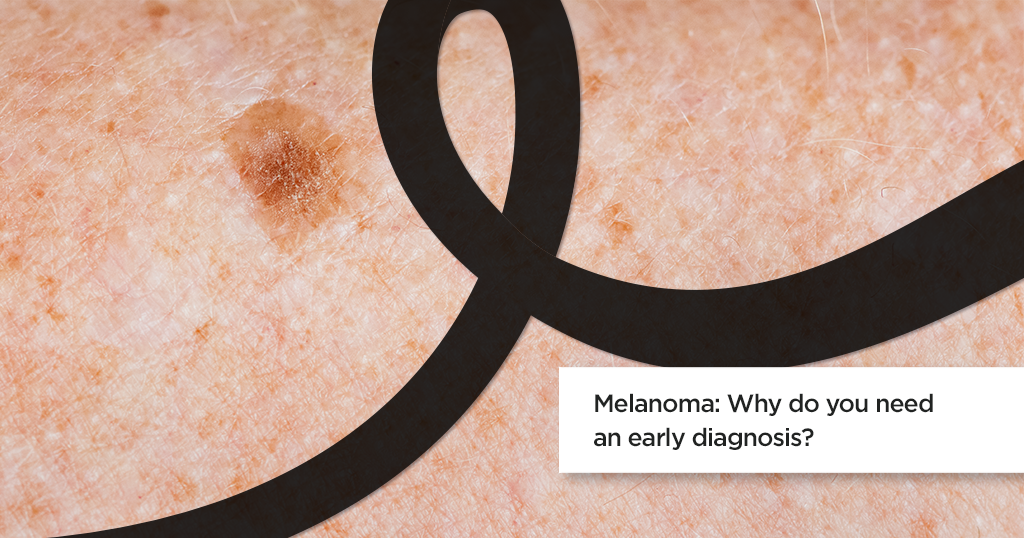Melanoma: Why Do You Need An Early Diagnosis?


Melanoma is a specific kind of skin cancer that develops from the pigment-producing cells in the skin known as melanocytes. The cancer develops in the cells (called melanocytes), which produce melanin, a pigment that gives skin color.
There are no specific causes associated with this type of cancer, but doctors warn against exposing the skin to excessive ultraviolet rays of the sun. People interested in tanning their skin artificially by using tanning beds and lamps are also at risk. Staying away from UV radiation is known to reduce the risks of melanoma significantly.
Surprisingly, most of the patients diagnosed with melanoma are below 40 years of age, with women being more at risk than men.
What is Melanoma?
The cells responsible for producing melanin, the color-forming pigment of the skin, are affected by this form of cancer. While it begins in the skin, it can spread rapidly to other parts of the body, including the eyes, brain, and various lymph nodes. There is a high possibility of detecting the skin changes early on with most patients and their family members noting the signs.
It is important to diagnose malignant melanoma early as this might help control the spreading of the cancer . Dermatologists or skin doctors can treat the melanoma . Melanoma can be treated completely if it is diagnosed early.
The reason for developing this kind of skin cancer has been associated with the unrestricted growth of melanocytes. The DNA present within the cells is damaged by exposure to ultraviolet rays causing it to mutate into a cancerous form. What damages DNA in the skin cells and how this leads to melanoma is not clear. It is likely that a combination of reasons, such as genetic and environmental factors, causes melanoma.
Also Read About: Squamous Cell Carcinoma of The Skin
Symptoms of Melanoma :
The appearance of a tiny mole on your skin is the first indication of melanoma. While it is likely to be ignored, you would have to visit a doctor to get it checked once you notice it changing color or growing in size. The same alterations may be seen in a mole that existed since birth.
Using the standard ABCDE method helps specialists to understand melanoma symptoms and make the right diagnosis. The process can be described by following the indications specified below.
- Asymmetry– Presence of an irregular shaped mole.
- Border– Irregular and uneven edges of the mole
- Color– The color is not uniform with dark and light shades
- Diameter– The diameter of the mole is bigger than that of a standard eraser
- Evolving or Elevation– There are frequent changes of size, shape, and texture of the mole
Some of the other symptoms that you may find include the following:
- Sores that are not healing
- The redness and elevation of the mole is spreading to reach areas outside the border of the mole
- Itchiness with the area being tender and inflamed
- Texture changes regularly with pus or blood oozing out from the mole
The symptoms of melanoma may vary from patient to patient, and not all moles are cancerous.
Risk Factors
- Excessive exposure to UV radiation
- Presence of multiple moles on our body
- Fair Skin
- Weak immune system
- Family history of melanoma, or other kinds of skin cancer
- Genetic defects
Diagnosis for Melanoma
- Physical exam: Your doctor may ask questions about your health history and may examine your skin to look for any sign that may show melanoma
- Biopsy (removing a sample tissue for testing). To conclude that a suspicious skin lesion is melanoma, your doctor will recommend removal of a skin sample for testing. The skin sample is then sent to a laboratory for examination.
Treatment for Melanoma
After checking the general health of the patient along with the stage of cancer and the extent of the area affected, the cancer specialist will decide the treatment. Some of the recognized treatments for this type of cancer may include :
Patients diagnosed with early or small-sized melanomas can recover after the mole is removed surgically along with the underlying tissue. Your surgeon will be able to remove it entirely during biopsy of the tissue if it has been diagnosed early enough.
Book an Appointment : Melanoma Treatment Doctors In India
- Surgery –Apart from surgical removal , the affected lymph nodes may also be removed. The doctor will also recommend additional treatment after the surgery.
- Chemotherapy – This is one of the classic methods for treating cancer. The drugs are provided to the patient as pills to be swallowed orally or given to them via intravenous injections.
- Immunotherapy– This kind of treatment stimulates the immune system to fight against the malignant cells.
- Radiation – This is targeted at the affected area in order to kill the malignant cells. This is the accepted form of treatment for patients unable to undergo surgery due to increased risks.
Targeted Therapy – Targeted drug therapies focus on certain weaknesses present within cancer cells. By targeting such weaknesses, targeted drug therapies can cause cancer cells to die.
Prevention for Melanoma
It is crucial to take adequate preventive measures in order to minimize the risks of melanoma along with other kinds of skin cancer. Try to take all the necessary precautions, including the following:
- Do not venture out in the afternoons, especially between 10 A.M. to 2 P. M.
- Make sure to cover yourself when you have to expose yourself to sunlight. Wear a hat, carry an umbrella, and keep your skin covered by donning long-sleeved dresses.
- Apply a quality sunscreen lotion or cream on your skin when stepping out during the day
- Self examine for moles or changes in moles regularly.
- Visit a doctor when you notice any unusual marks or changes in the moles on your skin (as mentioned above).
- Avoid tanning lamps and beds
FAQs of Melanoma
- What do early signs of melanoma look like?
Melanoma may begin as a spot or mole on the skin. It is advisable to consult a doctor if you notice the spot or mole changing its size, shape, or color.
- What are the causes of melanoma?
What damages DNA in the skin cells, and how this causes melanoma is not clear. It is likely that a combination of reasons, such as genetic and environmental factors, causes melanoma. Still, many doctors believe exposure to UV (ultraviolet) radiation from the sun or from tanning beds and lamps is the leading cause of melanoma.
- How does Melanoma make you feel?
Being diagnosed with this type of cancer will not make you feel any different during the early stages. There may be changes in the mole as described above. In melanoma that has spread to other organs, there may be symptoms such as:
- Swollen or painful lymph nodes
- Fatigue
- Weight loss
- A cough that does not go away or trouble breathing
- Loss of appetite
- Seizures
- Bone pain
- Headaches
- Swelling of the liver
- Can you have stage 4 melanoma and do not know about it?
Oncologists prefer to remove the cancerous cells at the earliest by surgery. However, some of the cells may metastasize or spread to other parts of the body to reach Stage 4. The symptoms may not be obvious initially but will progress rapidly, causing you discomfort.
- Can melanoma be completely cured?
Melanoma can be cured completely when it is diagnosed early. Do not lose hope if you reach stage 4, either. There are multiple treatment options available during the advanced stages too.
© Copyright 2024. Apollo Hospitals Group. All Rights Reserved.
 +91 8069991061
Book Health Check-up
+91 8069991061
Book Health Check-up







